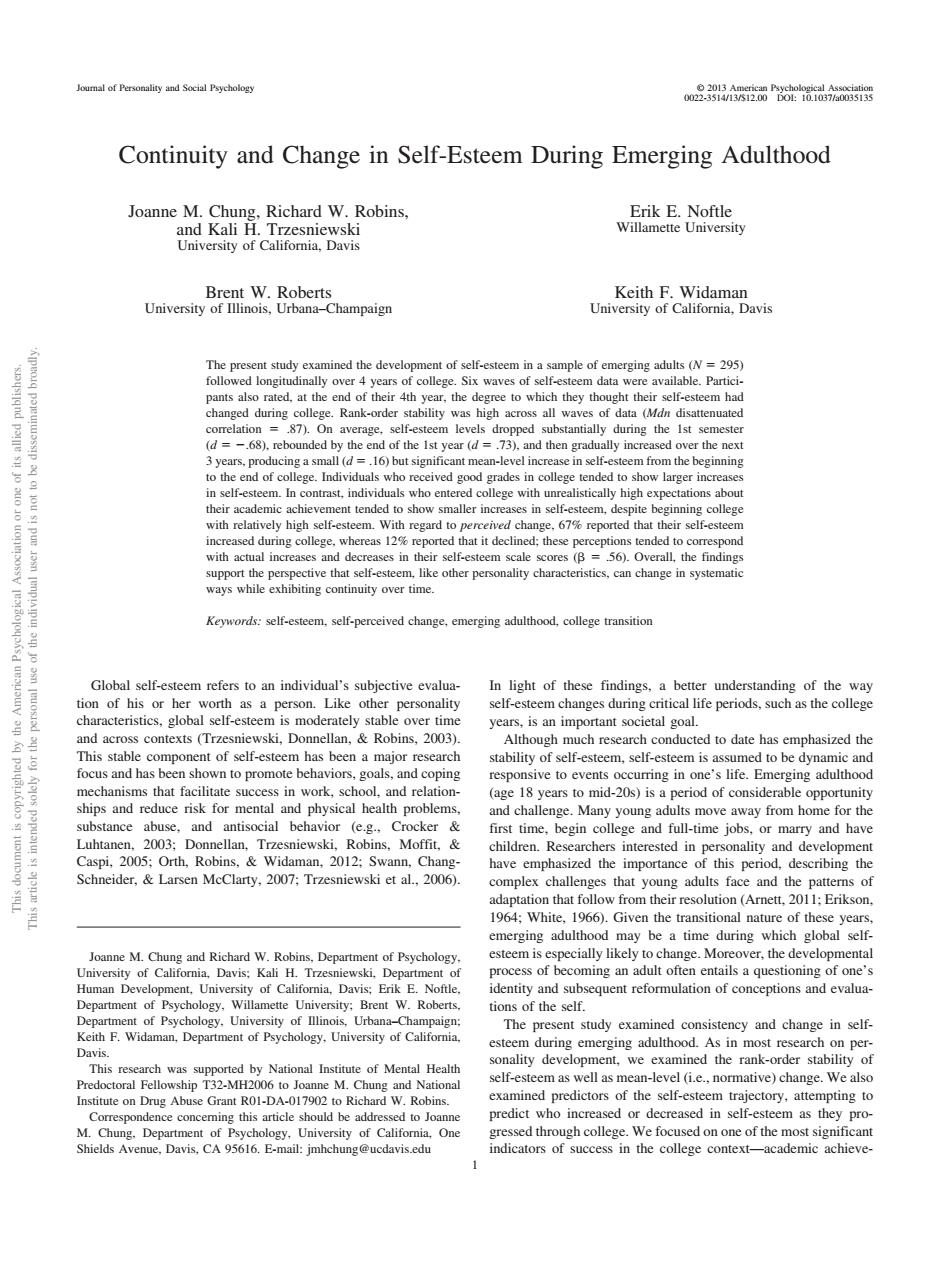正在加载图片...

o品8P Continuity and Change in Self-Esteem During Emerging Adulthood Richad W.Robins. wEak品aty uKetcMidmatoe mple of em d.at th r 4th the d hey thoug 7).0n during the Ist 16)but sign trom the vith re yhigh self- sel vith actual incr Keywords:self-estecm.self-perceived change.emerging adulthood.college transition Global se-emrefersto n subjective eval societal goa and across contexts(T skI,D n.Ro bins.2003 Ahough conducted to date has emphasized the opins esponsive toevents】 tance abuse, and antisocial beha (e.g.Crocker& first time.begin college and full-time jobs.or marry and have Schneider,Larsen McClarty,2007:Trzesniewski et al.,2006). 6) 1:Erikson emergin adulthood ma be a time during which global sef e M.Ch and Ric rd W.Ro De likely toc of t.U of Ca tityand subsequent of conceptions and aua of the se of Ca cy and ch m during emerging adultho od.As in m on per we ve the ra M h examined predictors of the self-esteem trajectory.attempting to this article s hould be One indicators of success in the college context-academic achieve-Continuity and Change in Self-Esteem During Emerging Adulthood Joanne M. Chung, Richard W. Robins, and Kali H. Trzesniewski University of California, Davis Erik E. Noftle Willamette University Brent W. Roberts University of Illinois, Urbana–Champaign Keith F. Widaman University of California, Davis The present study examined the development of self-esteem in a sample of emerging adults (N 295) followed longitudinally over 4 years of college. Six waves of self-esteem data were available. Participants also rated, at the end of their 4th year, the degree to which they thought their self-esteem had changed during college. Rank-order stability was high across all waves of data (Mdn disattenuated correlation .87). On average, self-esteem levels dropped substantially during the 1st semester (d .68), rebounded by the end of the 1st year (d .73), and then gradually increased over the next 3 years, producing a small (d .16) but significant mean-level increase in self-esteem from the beginning to the end of college. Individuals who received good grades in college tended to show larger increases in self-esteem. In contrast, individuals who entered college with unrealistically high expectations about their academic achievement tended to show smaller increases in self-esteem, despite beginning college with relatively high self-esteem. With regard to perceived change, 67% reported that their self-esteem increased during college, whereas 12% reported that it declined; these perceptions tended to correspond with actual increases and decreases in their self-esteem scale scores ( .56). Overall, the findings support the perspective that self-esteem, like other personality characteristics, can change in systematic ways while exhibiting continuity over time. Keywords: self-esteem, self-perceived change, emerging adulthood, college transition Global self-esteem refers to an individual’s subjective evaluation of his or her worth as a person. Like other personality characteristics, global self-esteem is moderately stable over time and across contexts (Trzesniewski, Donnellan, & Robins, 2003). This stable component of self-esteem has been a major research focus and has been shown to promote behaviors, goals, and coping mechanisms that facilitate success in work, school, and relationships and reduce risk for mental and physical health problems, substance abuse, and antisocial behavior (e.g., Crocker & Luhtanen, 2003; Donnellan, Trzesniewski, Robins, Moffit, & Caspi, 2005; Orth, Robins, & Widaman, 2012; Swann, ChangSchneider, & Larsen McClarty, 2007; Trzesniewski et al., 2006). In light of these findings, a better understanding of the way self-esteem changes during critical life periods, such as the college years, is an important societal goal. Although much research conducted to date has emphasized the stability of self-esteem, self-esteem is assumed to be dynamic and responsive to events occurring in one’s life. Emerging adulthood (age 18 years to mid-20s) is a period of considerable opportunity and challenge. Many young adults move away from home for the first time, begin college and full-time jobs, or marry and have children. Researchers interested in personality and development have emphasized the importance of this period, describing the complex challenges that young adults face and the patterns of adaptation that follow from their resolution (Arnett, 2011; Erikson, 1964; White, 1966). Given the transitional nature of these years, emerging adulthood may be a time during which global selfesteem is especially likely to change. Moreover, the developmental process of becoming an adult often entails a questioning of one’s identity and subsequent reformulation of conceptions and evaluations of the self. The present study examined consistency and change in selfesteem during emerging adulthood. As in most research on personality development, we examined the rank-order stability of self-esteem as well as mean-level (i.e., normative) change. We also examined predictors of the self-esteem trajectory, attempting to predict who increased or decreased in self-esteem as they progressed through college. We focused on one of the most significant indicators of success in the college context—academic achieveJoanne M. Chung and Richard W. Robins, Department of Psychology, University of California, Davis; Kali H. Trzesniewski, Department of Human Development, University of California, Davis; Erik E. Noftle, Department of Psychology, Willamette University; Brent W. Roberts, Department of Psychology, University of Illinois, Urbana–Champaign; Keith F. Widaman, Department of Psychology, University of California, Davis. This research was supported by National Institute of Mental Health Predoctoral Fellowship T32-MH2006 to Joanne M. Chung and National Institute on Drug Abuse Grant R01-DA-017902 to Richard W. Robins. Correspondence concerning this article should be addressed to Joanne M. Chung, Department of Psychology, University of California, One Shields Avenue, Davis, CA 95616. E-mail: jmhchung@ucdavis.edu This document is copyrighted by the American Psychological Association or one of its allied publishers. This article is intended solely for the personal use of the individual user and is not to be disseminated broadly. Journal of Personality and Social Psychology © 2013 American Psychological Association 2013, Vol. 106, No. 1, 000 0022-3514/13/$12.00 DOI: 10.1037/a0035135 1��